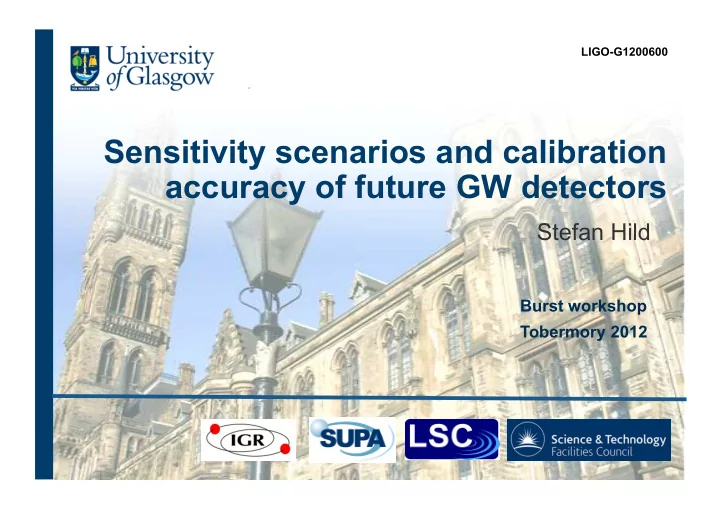

LIGO-G1200600 Sensitivity scenarios and calibration accuracy of future GW detectors Stefan Hild Burst workshop Tobermory 2012
What sensitivity can future GW detectors achieve? • With 2 nd generation instruments under construction it is now time to look what comes afterwards. • In Europe the design study for the third generation Einstein telescope (based on an underground xylophone with 10km armlength) has been completed. https://tds.ego-gw.it/itf/tds/index.php?callContent=2&callCode=8709 • During the last year the LSC started to look at aLIGO upgrades LIGO-T1200031 S.Hild, Tobermory 2012 Slide 1
LIGO-3 Red Team design • Only rather mature technologies considered • Overall an improvement of a factor 3 at all frequencies above 100 Hz. And a factor 3-4 below 100Hz. • The binary neutron star inspiral range would improve from about 200 Mpc to above 600 Mpc. • Rough hardware cost is 20 million $. So you can 'buy' sensitivity at a cost of 20Mpc/million $ . S.Hild, Tobermory 2012 Slide 2
More Details of the Team Red Design • For details please see documents on the DCC: • 50 page long description of the Team Red Design can be found at https:// dcc.ligo.org/cgi-bin/private/DocDB/ ShowDocument?docid=78100 • The sensitivity data for the Team Red design are available at https:// dcc.ligo.org/cgi-bin/private/DocDB/ ShowDocument?docid=86562 S.Hild, Tobermory 2012 Slide 3
Credit: H.Lueck, GWADW 2012 LIGO-G1200578-v3 S.Hild, Tobermory 2012 Slide 4
Discussion Points • In what frequency range shall we push for improvement of the GW detectors? – So far always focussed on broadband improvements. – However, technically there are ample of opportunities to emphasis a certain frequency range (which obviously comes at the cost of de- emphasising other frequency ranges). – Can you think of burst-specific figure of merit that can be used as quantitaive guidance for the configuration choice? • What calibration accuracy is required to do good science? – Absolut calibration, frequency dependent error, sub-second time scale? – So far we have aimed for 10% and 10deg (and usually done a bit better in the end). – 'Insufficient' calibration might harm network analyses, null streams etc… – Would be good to have a quantitave motivation for the calibration requirement, rather than going for the 'as good as we can' approach. S.Hild, Tobermory 2012 Slide 5
YOUR input required ! • For both (ET and LIGO3) input from your side is more than welcome! • How shall we 'shape' the sensitivity for you to get the best science out of the data? • What requirements do your searches have in terms of calibration? • Let me know and we will try to 'deliver' … S.Hild, Tobermory 2012 Slide 6
EXTRA SLIDES Slide 7 GWADW, Hawaii, May 2012 S.Hild, Tobermory 2012 Stefan Hild
S.Hild, Tobermory 2012 Slide 8 Credit: D.Shoemaker and G.Losurdo LIGO-G1000176-v7
Signal-Recycling (de)tuning Advanced Virgo, Power = 125W, SR-transmittance = 4% knob 1 • Frequency of pure optical resonance goes down with SR-tuning. • Frequency of opto-mechanical resonance goes up with SR-tuning S.Hild, Tobermory 2012
Signal-Recycling mirror transmittance Advanced Virgo, Power = 125W, SR-tuning = 0.07 knob 2 • Resonances are less developed for larger SR transmittance. S.Hild, Tobermory 2012
Knob 3: Optical Power Advanced Virgo, SR-tuning=0.07, SR-transmittance = 4% knob 3 • High frequency sensitivity improves with higher power (Shotnoise) • Low frequency sensitivity decreases with higher power (Radiation pressure noise) S.Hild, Tobermory 2012
Jun's Theorem Laser wavelength Bandwidth of Peak sensitivity The 'bucket' Energy stored In the IFO • Theorem from Jun Mizuno (PhD thesis 1995). • "Any configuration storing the same amount of energy will have the same sensitivity when optimised for the same bandwidth." S.Hild, Tobermory 2012
Jun's Theorem: aLIGO as example ~500 Hz 1064nm 10J S.Hild, Tobermory 2012
Detuned RSE • How about detuned RSE? – Can give improved HF sensitivity, but on a hugely reduced LF sensitivity. – Also losses will pose a limit on how narrow band you can do the RSE. – Perhaps for this better to use delay lines + signal recycling. Something like GEO style interferometer with 10km arm length. S.Hild, Tobermory 2012
How does the red design compare to blue and green? Interesting/surprising how similar they are … S.Hild, Tobermory 2012 Slide 15
Recommend
More recommend